
Hierarchy of angels
Encyclopedia
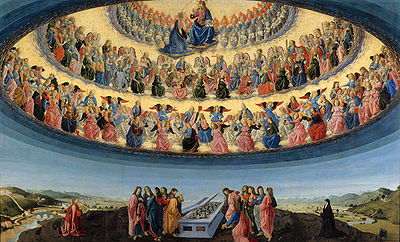
- For other angelic hierarchies, see Hierarchy of angelsHierarchy of angelsThe most influential Christian angelic hierarchy was that put forward by Pseudo-Dionysius the Areopagite in the 4th or 5th century in his book De Coelesti Hierarchia . During the Middle Ages, many schemes were proposed, some drawing on and expanding on Pseudo-Dionysius, others suggesting completely...
.
The most influential Christian angelic hierarchy was that put forward by Pseudo-Dionysius the Areopagite
Pseudo-Dionysius the Areopagite
Pseudo-Dionysius the Areopagite, also known as Pseudo-Denys, was a Christian theologian and philosopher of the late 5th to early 6th century, the author of the Corpus Areopagiticum . The author is identified as "Dionysos" in the corpus, which later incorrectly came to be attributed to Dionysius...
in the 4th or 5th century in his book De Coelesti Hierarchia
De Coelesti Hierarchia
De Coelesti Hierarchia is a Pseudo-Dionysian work on angelology which exerted great influence on scholasticism...
(The Celestial Hierarchy). During the Middle Ages
Middle Ages
The Middle Ages is a periodization of European history from the 5th century to the 15th century. The Middle Ages follows the fall of the Western Roman Empire in 476 and precedes the Early Modern Era. It is the middle period of a three-period division of Western history: Classic, Medieval and Modern...
, many schemes were proposed, some drawing on and expanding on Pseudo-Dionysius, others suggesting completely different classifications. According to medieval
Middle Ages
The Middle Ages is a periodization of European history from the 5th century to the 15th century. The Middle Ages follows the fall of the Western Roman Empire in 476 and precedes the Early Modern Era. It is the middle period of a three-period division of Western history: Classic, Medieval and Modern...
Christian theologians
Christian theology
- Divisions of Christian theology :There are many methods of categorizing different approaches to Christian theology. For a historical analysis, see the main article on the History of Christian theology.- Sub-disciplines :...
, the angel
Angel
Angels are mythical beings often depicted as messengers of God in the Hebrew and Christian Bibles along with the Quran. The English word angel is derived from the Greek ἄγγελος, a translation of in the Hebrew Bible ; a similar term, ملائكة , is used in the Qur'an...
s are organized into several orders, or "Angelic Choirs".
Pseudo-Dionysius (The Celestial Hierarchy) and Thomas Aquinas (Summa Theologica
Summa Theologica
The Summa Theologiæ is the best-known work of Thomas Aquinas , and although unfinished, "one of the classics of the history of philosophy and one of the most influential works of Western literature." It is intended as a manual for beginners in theology and a compendium of all of the main...
) drew on passages from the New Testament
New Testament
The New Testament is the second major division of the Christian biblical canon, the first such division being the much longer Old Testament....
, specifically Ephesians
Epistle to the Ephesians
The Epistle of Paul to the Ephesians, often shortened to Ephesians, is the tenth book of the New Testament. Its authorship has traditionally been credited to Paul, but it is considered by some scholars to be "deutero-Pauline," that is, written in Paul's name by a later author strongly influenced by...
1:21 and Colossians
Epistle to the Colossians
The Epistle of Paul to the Colossians, usually referred to simply as Colossians, is the 12th book of the New Testament. It was written, according to the text, by Paul the Apostle to the Church in Colossae, a small Phrygian city near Laodicea and approximately 100 miles from Ephesus in Asia...
1:16, in an attempt to develop a schema of three Hierarchies, Spheres or Triads of angels, with each Hierarchy containing three Orders or Choirs.
Seraphim
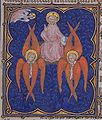
Throne of God
The Throne of God is the reigning centre of the chief deity of the Abrahamic faiths, Judaism, Christianity and Islam. The throne is said by various holy books to reside above the Seventh Heaven called Araboth in Judaism.-Judaism:...
and continuously shout praises: "Holy, holy, holy is the Lord of hosts. All the earth is filled with His Glory." The name Seraphim means "the burning ones." The Seraphim have six wings.
Two of the Seraphim are named Seraphiel
Seraphiel
Seraphiel is the name of an angel in the apocryphal Book of Enoch.Protector of Metatron, Seraphiel holds the highest rank of the Seraphim with the following directly below him, Jehoel. In some texts, he is referred to as the Angel of Silence...
and Metatron
Metatron
Metatron or Mattatron is the name of an angel in Judaism and some branches of Christian mythology. There are no references to him in the Jewish Tanakh or Christian Scriptures...
, according to some books. Seraphiel is said to have the head of an eagle. It is said that such a bright light emanates from them that nothing, not even other angelic beings, can look upon them. It is also said that there are four of them surrounding God's throne, where they burn eternally from love and zeal for God.
Cherubim
Cherubim have four faces: one of each a manMan
The term man is used for an adult human male . However, man is sometimes used to refer to humanity as a whole...
, an ox
Ox
An ox , also known as a bullock in Australia, New Zealand and India, is a bovine trained as a draft animal. Oxen are commonly castrated adult male cattle; castration makes the animals more tractable...
, a lion
Lion
The lion is one of the four big cats in the genus Panthera, and a member of the family Felidae. With some males exceeding 250 kg in weight, it is the second-largest living cat after the tiger...
, and a griffon vulture
Griffon Vulture
The Griffon Vulture is a large Old World vulture in the bird of prey family Accipitridae.The Griffon Vulture is long with a wingspan. In the nominate race the males weigh and females typically weigh , while in the Indian subspecies the vultures average...
. They have four conjoined wings covered with eyes, a lion's body figure, and they have ox's feet. Cherubim guard the way to the tree of life in the Garden of Eden
Garden of Eden
The Garden of Eden is in the Bible's Book of Genesis as being the place where the first man, Adam, and his wife, Eve, lived after they were created by God. Literally, the Bible speaks about a garden in Eden...
(Genesis 3:24) and the throne of God (Ezekiel 28:14-16).
The cherubim are mentioned in Genesis 3:24; Exodus 25:17-22; 2 Chronicles 3:7-14; Ezekiel 10:12–14, 28:14-16; 1 Kings 6:23–28; and Revelation 4:6-8.
Modern English usage has blurred the distinction between cherubim and putti
Putto
A putto is a figure of an infant often depicted as a young male. Putti are defined as chubby, winged or wingless, male child figure in nude. Putti are distinct from cherubim, but some English-speakers confuse them with each other, except that in the plural, "the Cherubim" refers to the biblical...
. Putti are the winged human baby/toddler-like beings traditionally used in figurative art.
St. Thomas Aquinas theorized that Satan
Satan
Satan , "the opposer", is the title of various entities, both human and divine, who challenge the faith of humans in the Hebrew Bible...
is a fallen Cherub.
Thrones or Ophanim
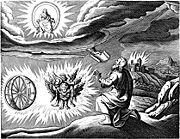
Greek language
Greek is an independent branch of the Indo-European family of languages. Native to the southern Balkans, it has the longest documented history of any Indo-European language, spanning 34 centuries of written records. Its writing system has been the Greek alphabet for the majority of its history;...
thronos) or Elders, also known as the Erelim or Ophanim, are a class of celestial
Celestial
- Science :* Sky objects, bodies and the following astronomy terms:** Astronomical objects, see for detailed description of celestial bodies and objects** Celestia, a 3D astronomy program that allows users to travel through the universe...
beings mentioned by Paul of Tarsus
Paul of Tarsus
Paul the Apostle , also known as Saul of Tarsus, is described in the Christian New Testament as one of the most influential early Christian missionaries, with the writings ascribed to him by the church forming a considerable portion of the New Testament...
in Colossians 1:16 (New Testament). They are living symbols of God's justice and authority, and have as one of their symbols the throne
Throne
A throne is the official chair or seat upon which a monarch is seated on state or ceremonial occasions. "Throne" in an abstract sense can also refer to the monarchy or the Crown itself, an instance of metonymy, and is also used in many expressions such as "the power behind the...
. These high celestial beings appear to be mentioned again in Revelation 11:16.
The Ophanim (Heb. ofanim: Wheels, also known as Thrones, from the vision of ) are unusual looking even compared to the other celestial beings; They appear as a beryl
Beryl
The mineral beryl is a beryllium aluminium cyclosilicate with the chemical formula Be3Al26. The hexagonal crystals of beryl may be very small or range to several meters in size. Terminated crystals are relatively rare...
-coloured wheel-within-a-wheel, their rims covered with hundreds of eyes.
They are closely connected with the Cherubim: "When they moved, the others moved; when they stopped, the others stopped; and when they rose from the earth, the wheels rose along with them; for the spirit of the living creatures [Cherubim] was in the wheels." Ezekiel 10:17 NRSV.
Second Sphere
Angels of the Second Sphere work as heavenlyHeaven (Christianity)
Traditionally, Christianity has taught Heaven as a place of eternal life and the dwelling place of Angels and the Throne of God, and a kingdom to which all the elect will be admitted...
governors.
Dominions
The "Dominions" (lat. dominatio, plural dominationes, also translated from the Greek term kyriotites as "Lordships") are presented as the hierarchy of celestial beings "Lordships" in the De Coelesti Hierarchia. The Dominions, also known as the HashmallimHashmallim
Hashmallim are an angelic entity in both Judaism and Christianity.They appear in the Hebrew Bible in Ezekiel 1:4Hashmallim occupy the fourth rank of ten in Maimonides's exposition of the Jewish Angelarchy....
, regulate the duties of lower angels. It is only with extreme rarity that the angelic lords make themselves physically known to humans. They are also the angels who preside over nations.
The Dominions are believed to look like divinely beautiful humans with a pair of feathered wings, much like the common representation of angels, but they may be distinguished from other groups by wielding orbs of light fastened to the heads of their scepters or on the pommel of their swords.
Virtues
The "Virtues" or "Strongholds" lie beyond the ophanim (Thrones/Wheels). Their primary duty is to supervise the movements of the heavenly bodies in order to ensure that the cosmos remains in order.The term appears to be linked to the attribute "might", from the Greek root "δύναμις" in Ephesians 1:21, which is also translated as "Virtue". They are presented as the celestial Choir "Virtues", in the Summa Theologica. Traditional theological conceptions of the Virtues might appear to describe the same Order called the Thrones (Gr. thronos), (in which case the Ophanim may not be the same thing as "Thrones").
From Pseudo-Dionysius the Areopagite
Pseudo-Dionysius the Areopagite
Pseudo-Dionysius the Areopagite, also known as Pseudo-Denys, was a Christian theologian and philosopher of the late 5th to early 6th century, the author of the Corpus Areopagiticum . The author is identified as "Dionysos" in the corpus, which later incorrectly came to be attributed to Dionysius...
's De Coelesti Hierarchia
De Coelesti Hierarchia
De Coelesti Hierarchia is a Pseudo-Dionysian work on angelology which exerted great influence on scholasticism...
:
"The name of the holy Virtues signifies a certain powerful and unshakable virility welling forth into all their Godlike energies; not being weak and feeble for any reception of the divine Illuminations granted to it; mounting upwards in fullness of power to an assimilation with God; never falling away from the Divine Life through its own weakness, but ascending unwaveringly to the superessential Virtue which is the Source of virtue: fashioning itself, as far as it may, in virtue; perfectly turned towards the Source of virtue, and flowing forth providentially to those below it, abundantly filling them with virtue."
Powers or Authorities
The "Powers" (latLatin
Latin is an Italic language originally spoken in Latium and Ancient Rome. It, along with most European languages, is a descendant of the ancient Proto-Indo-European language. Although it is considered a dead language, a number of scholars and members of the Christian clergy speak it fluently, and...
. potestas (f), pl. potestates), or "Authorities", from the Greek exousies, (see Greek root in Eph 3:10) appear to collaborate, in power and authority, with the Principalities (Rulers).
The Powers are the bearers of conscience and the keepers of history. They are also the warrior angels created to be completely loyal to God. Some believe that no Power has ever fallen from grace, but another theory states that Satan
Satan
Satan , "the opposer", is the title of various entities, both human and divine, who challenge the faith of humans in the Hebrew Bible...
was the Chief of the Powers before he Fell (see also ). Their duty is to oversee the distribution of power among humankind, hence their name.
Paul used the term rule and authority in Ephesians 1:21 http://www.bible.org/netbible/eph1.htm, and rulers and authorities in Ephesians 3:10 http://www.bible.org/netbible/eph3.htm. He may have been referring to the rulers and authorities of humanity, instead of referring to angels.
Principalities or Rulers
The "Principalities" (latLatin
Latin is an Italic language originally spoken in Latium and Ancient Rome. It, along with most European languages, is a descendant of the ancient Proto-Indo-European language. Although it is considered a dead language, a number of scholars and members of the Christian clergy speak it fluently, and...
. principatus, pl. principatūs) also translated as "Princedoms" and "Rulers", from the Greek arche (see Greek root in Eph 3:10), appear to collaborate, in power and authority with the Powers (Authorities).
The Principalities are shown wearing a crown and carrying a sceptre
Sceptre
A sceptre is a symbolic ornamental rod or wand borne in the hand by a ruling monarch as an item of royal or imperial insignia.-Antiquity:...
. Their duty also is said to be to carry out the orders given to them by the Dominions and bequeath blessings to the material world. Their task is to oversee groups of people. They are the educators and guardians of the realm of earth. Like beings related to the world of the germinal ideas, they are said to inspire living things to many things such as art
Art
Art is the product or process of deliberately arranging items in a way that influences and affects one or more of the senses, emotions, and intellect....
or science
Science
Science is a systematic enterprise that builds and organizes knowledge in the form of testable explanations and predictions about the universe...
.
Paul used the term rule and authority in Ephesians 1:21 http://www.bible.org/netbible/eph1.htm, and rulers and authorities in Ephesians 3:10 http://www.bible.org/netbible/eph3.htm. He may have been referring to the rulers and authorities of men or societies, instead of referring to angels.
Archangels

New Testament
The New Testament is the second major division of the Christian biblical canon, the first such division being the much longer Old Testament....
: and . Only Archangels Gabriel and Michael are mentioned by name in the New Testament.
Michael is the only angel the Bible named expressly as "the" archangel. In the Book of Daniel
Book of Daniel
The Book of Daniel is a book in the Hebrew Bible. The book tells of how Daniel, and his Judean companions, were inducted into Babylon during Jewish exile, and how their positions elevated in the court of Nebuchadnezzar. The court tales span events that occur during the reigns of Nebuchadnezzar,...
he is referred to as "one of the chief princes". The word "prince" here is the ancient Hebrew word sar, which means: "a head person (of any rank or class), a chief, a general etc."
In most Christian traditions Gabriel is also considered an archangel, but there is no direct literal support for this assumption.
The name of the archangel Raphael appears only in the Book of Tobit
Book of Tobit
The Book of Tobit is a book of scripture that is part of the Catholic and Orthodox biblical canon, pronounced canonical by the Council of Carthage of 397 and confirmed for Roman Catholics by the Council of Trent...
(Tobias). Tobit is considered Deuterocanonical
Deuterocanonical books
Deuterocanonical books is a term used since the sixteenth century in the Catholic Church and Eastern Christianity to describe certain books and passages of the Christian Old Testament that are not part of the Hebrew Bible. The term is used in contrast to the protocanonical books, which are...
by Roman Catholics (both Eastern and Western Rites) and Eastern Orthodox Christians. The Book of Tobit is also read by Anglicans and Lutherans, but not by Reformed Christians or Baptists. Raphael said to Tobias that he was "one of the seven who stand before the Lord", and it is generally believed that Michael and Gabriel are two of the other six.
A fourth Archangel is Uriel
Uriel
Uriel is one of the archangels of post-Exilic Rabbinic tradition, and also of certain Christian traditions...
whose name literally means "Fire of God" or "Light of God." Uriel's name is the only one not mentioned in the Lutheran Bible, but plays, however, a prominent role in an apocryphon
Apocryphon
"Apocryphon" , plural apocrypha, was a Greek term for a genre of Jewish and Early Christian writings that were meant to impart "secret teachings" or gnosis that could not be publicly taught...
read by Anglican and Russian Orthodox Christians: The second Book of Esdras (fourth Books of Esdras in the Latin Vulgate). In the book he unveils seven prophecies to the prophet Ezra
Ezra
Ezra , also called Ezra the Scribe and Ezra the Priest in the Book of Ezra. According to the Hebrew Bible he returned from the Babylonian exile and reintroduced the Torah in Jerusalem...
, after whom the book is named. He also plays a role in the apocryphal Book of Enoch
Book of Enoch
The Book of Enoch is an ancient Jewish religious work, traditionally ascribed to Enoch, the great-grandfather of Noah. It is not part of the biblical canon as used by Jews, apart from Beta Israel...
, which is considered canonical only by the Ethiopian Orthodox Church.
Another possible interpretation of the seven archangels is that the seven are the seven spirits of God that stand before the throne described in the Book of Enoch
Book of Enoch
The Book of Enoch is an ancient Jewish religious work, traditionally ascribed to Enoch, the great-grandfather of Noah. It is not part of the biblical canon as used by Jews, apart from Beta Israel...
, and in the Book of Revelation
Revelation
In religion and theology, revelation is the revealing or disclosing, through active or passive communication with a supernatural or a divine entity...
.
The Seven Archangels
Seven Archangels
The earliest reference to a system of seven archangels as a group appears to be in Enoch I which is not part of the Jewish Canon, where they are named as Gabriel, Michael, Raphael, Uriel, Raguel, Remiel and Saraqael...
are said to be the guardian angels of nations and countries, and are concerned with the issues and events surrounding these, including politics, military matters, commerce and trade: e.g. Archangel Michael is traditionally seen as the protector of Israel
Israel
The State of Israel is a parliamentary republic located in the Middle East, along the eastern shore of the Mediterranean Sea...
and of the ecclesia
Ecclesia
-Ecclesia:* the Christian Church**See Church militant and church triumphant for ecclesia militans, ecclesia penitens, ecclesia triumphans* Congregation among many English-speaking Christadelphians....
(Gr.
Greek language
Greek is an independent branch of the Indo-European family of languages. Native to the southern Balkans, it has the longest documented history of any Indo-European language, spanning 34 centuries of written records. Its writing system has been the Greek alphabet for the majority of its history;...
root ekklesia from the New Testament
New Testament
The New Testament is the second major division of the Christian biblical canon, the first such division being the much longer Old Testament....
passages), theologically equated as the Church, the forerunner of the spiritual New Israel
New Galilee (Sixth Epoch)
The New Galilee is the name given in the Western Wisdom Teachings to the New Jerusalem mentioned in the Bible. According to these Christian esoteric teachings, the New Galilee represents the future Sixth Epoch in mankind's evolutionary path and will see the transition of humanity to the etheric...
.
It is possible to make a distinction between archangel (with a lower-case a) and Archangel (with an uppercase A). The former can denote the second-lowest choir (arch-angels in the sense of being just above the lowest Choir of angels that is called only "angels") but the latter may denote the highest of all the angels (i.e., Arch-angels in the sense of being above all angels, of any Choir. The seven highest Seraphim, Michael being the highest of all, once Satan fell).
Angels
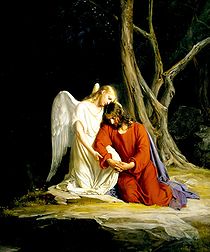
Choirs scheme in medieval theology
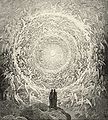
Middle Ages
The Middle Ages is a periodization of European history from the 5th century to the 15th century. The Middle Ages follows the fall of the Western Roman Empire in 476 and precedes the Early Modern Era. It is the middle period of a three-period division of Western history: Classic, Medieval and Modern...
, many schemes were proposed, some drawing on and expanding on Pseudo-Dionysius, others suggesting completely different classifications (some authors limited the number of Choirs to seven). Several other hierarchies were proposed, some in nearly inverted order. Some of those schemes are here presented:
- Clement of RomePope Clement IStarting in the 3rd and 4th century, tradition has identified him as the Clement that Paul mentioned in Philippians as a fellow laborer in Christ.While in the mid-19th century it was customary to identify him as a freedman of Titus Flavius Clemens, who was consul with his cousin, the Emperor...
in Apostolic ConstitutionsApostolic ConstitutionsThe Apostolic Constitutions is a Christian collection of eight treatises which belongs to genre of the Church Orders. The work can be dated from 375 to 380 AD. The provenience is usually regarded as Syria, probably Antioch...
(1st century):- 1. Seraphim, 2. Cherubim, 3. Aeons, 4. Hosts, 5. Powers, 6. Authorities, 7. Principalities, 8. Thrones, 9. Archangels, 10. Angels, 11. Dominions.
- St. AmbroseAmbroseAurelius Ambrosius, better known in English as Saint Ambrose , was a bishop of Milan who became one of the most influential ecclesiastical figures of the 4th century. He was one of the four original doctors of the Church.-Political career:Ambrose was born into a Roman Christian family between about...
in Apologia Prophet David, 5 (4th century):- 1. Seraphim, 2. Cherubim, 3. Dominations, 4. Thrones, 5. Principalities, 6. Potentates (or Powers), 7. Virtues, 8. Angels, 9. Archangels.
- St. JeromeJeromeSaint Jerome was a Roman Christian priest, confessor, theologian and historian, and who became a Doctor of the Church. He was the son of Eusebius, of the city of Stridon, which was on the border of Dalmatia and Pannonia...
(4th century):- 1. Seraphim, 2. Cherubim, 3. Powers, 4. Dominions (Dominations), 5. Thrones, 6. Archangels, 7. Angels.
- Pseudo-Dionysius the AreopagitePseudo-Dionysius the AreopagitePseudo-Dionysius the Areopagite, also known as Pseudo-Denys, was a Christian theologian and philosopher of the late 5th to early 6th century, the author of the Corpus Areopagiticum . The author is identified as "Dionysos" in the corpus, which later incorrectly came to be attributed to Dionysius...
in De Coelesti HierarchiaDe Coelesti HierarchiaDe Coelesti Hierarchia is a Pseudo-Dionysian work on angelology which exerted great influence on scholasticism...
(ca. 5th century):- First sphere: 1. Seraphim, 2. Cherubim, 3. Thrones;
- Second sphere: 4. Authorities, 5. Lordships, 6. Powers;
- Third sphere: 7. Principalities, 8. Archangels, 9. Angels.
- St. Gregory the GreatPope Gregory IPope Gregory I , better known in English as Gregory the Great, was pope from 3 September 590 until his death...
in Homilia (6th century)- 1. Seraphim, 2. Cherubim, 3. Thrones, 4. Dominations, 5. Principalities, 6. Powers, 7. Virtues, 8. Archangels, 9. Angels.
- St. Isidore of SevilleIsidore of SevilleSaint Isidore of Seville served as Archbishop of Seville for more than three decades and is considered, as the historian Montalembert put it in an oft-quoted phrase, "le dernier savant du monde ancien"...
in Etymologiae (7th century):- 1. Seraphim, 2. Cherubim, 3. Powers, 4. Principalities, 5. Virtues, 6. Dominations, 7. Thrones, 8. Archangels, 9. Angels.
- John of DamascusJohn of DamascusSaint John of Damascus was a Syrian monk and priest...
in De Fide Orthodoxa (8th century):- 1. Seraphim, 2. Cherubim, 3. Thrones, 4. Dominions, 5. Powers, 6. Authorities (Virtues), 7. Rulers (Principalities), 8. Archangels, 9. Angels.
- Blessed Hildegard of BingenHildegard of BingenBlessed Hildegard of Bingen , also known as Saint Hildegard, and Sibyl of the Rhine, was a German writer, composer, philosopher, Christian mystic, Benedictine abbess, visionary, and polymath. Elected a magistra by her fellow nuns in 1136, she founded the monasteries of Rupertsberg in 1150 and...
in SciviasSciviasScivias is an illustrated work by Hildegard von Bingen, completed in 1151 or 1152, describing 26 religious visions she experienced. It is the first of three works that she wrote describing her visions, the others being Liber vitae meritorum and De operatione Dei...
(1098–1179):- 1. Seraphim, Cherubim;
- 2. Thrones, Dominations, Principalities, Powers and Virtues;
- 3. Archangels and Angels.
- St. Thomas AquinasThomas AquinasThomas Aquinas, O.P. , also Thomas of Aquin or Aquino, was an Italian Dominican priest of the Catholic Church, and an immensely influential philosopher and theologian in the tradition of scholasticism, known as Doctor Angelicus, Doctor Communis, or Doctor Universalis...
in Summa TheologicaSumma TheologicaThe Summa Theologiæ is the best-known work of Thomas Aquinas , and although unfinished, "one of the classics of the history of philosophy and one of the most influential works of Western literature." It is intended as a manual for beginners in theology and a compendium of all of the main...
(1225–1274):- 1. Seraphim, Cherubim, and Thrones;
- 2. Dominations, Virtues, and Powers;
- 3. Principalities, Archangels, and Angels.
- Dante AlighieriDante AlighieriDurante degli Alighieri, mononymously referred to as Dante , was an Italian poet, prose writer, literary theorist, moral philosopher, and political thinker. He is best known for the monumental epic poem La commedia, later named La divina commedia ...
in The Divine ComedyThe Divine ComedyThe Divine Comedy is an epic poem written by Dante Alighieri between 1308 and his death in 1321. It is widely considered the preeminent work of Italian literature, and is seen as one of the greatest works of world literature...
(1308–1321)- 1. Seraphim, 2. Cherubim, 3. Thrones, 4. Dominations, 5. Virtues, 6. Powers, 7. Principalities, 8. Archangels, 9. Angels.
See also
- Dynamics of the celestial spheresDynamics of the celestial spheresAncient, medieval and Renaissance astronomers and philosophers developed many different theories about the dynamics of the celestial spheres. They explained the motions of the various nested spheres in terms of the materials of which they were made, external movers such as celestial intelligences,...
- Fallen angelFallen angelFallen angel is a concept developed in Jewish mythology from interpretation of the Book of Enoch. The actual term fallen angel is not found in either the Hebrew Bible or the New Testament. Christians adopted the concept of fallen angels mainly based on their interpretations of the Book of...
- Heavenly hostHeavenly hostHeavenly host refers to an army of good angels mentioned in the Bible. It is led either by the Archangel Michael, Jesus, or by God himself. Most descriptions of angels in the Bible describe them in military terms, such as encampment , command structure , and combat...
- Hierarchy of angelsHierarchy of angelsThe most influential Christian angelic hierarchy was that put forward by Pseudo-Dionysius the Areopagite in the 4th or 5th century in his book De Coelesti Hierarchia . During the Middle Ages, many schemes were proposed, some drawing on and expanding on Pseudo-Dionysius, others suggesting completely...
- Islamic angelic hierarchy
- Jewish angelic hierarchyJewish angelic hierarchyMaimonides, in his Yad ha-Chazakah: Yesodei ha-Torah, counts ten ranks of angels in the Jewish angelic hierarchy, beginning from the highest:- Kabbalistic angelic hierarchy :...
- Zoroastrian angelic hierarchyYazataYazata is the Avestan language word for a Zoroastrian concept. The word has a wide range of meanings but generally signifies a divinity...
Further reading
- C. A. PatridesC. A. PatridesConstantinos Apostolos Patrides was a Greek–American academic and writer, and “one of the greatest scholars of Renaissance literature of his generation”. His books list the name C. A. Patrides; his Christian name “Constantinos” was shortened to the familiar “Dinos” and “Dean” by friends.Born...
. "On the orders of angels" (Chapter one). Premises and Motifs in Renaissance Thought and Literature (Princeton, 1982) ISBN 0691065055

